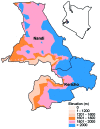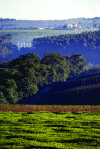Malaria in Kenya's western highlands
- PMID: 16229773
- PMCID: PMC3310610
- DOI: 10.3201/eid1109.041131
Malaria in Kenya's western highlands
Abstract
Records from tea estates in the Kericho district in Kenya show that malaria reemerged in the 1980s. Renewed epidemic activity coincided with the emergence of chloroquine-resistant Plasmodium falciparum malaria and may have been triggered by the failure of antimalarial drugs. Meteorologic changes, population movements, degradation of health services, and changes in Anopheles vector populations are possible contributing factors. The highland malaria epidemics of the 1940s were stopped largely by sporontocidal drugs, and combination chemotherapy has recently limited transmission. Antimalarial drugs can limit the pool of gametocytes available to infect mosquitoes during the brief transmission season.
Figures







References
-
- Roberts JM. The control of epidemic malaria in the highlands of western Kenya. 3. After the campaign. J Trop Med Hyg. 1964;67:230–7. - PubMed
Publication types
MeSH terms
Substances
Grants and funding
LinkOut - more resources
Full Text Sources
